Study on the Effect of Bridge Deck Spacing on Characteristics of Smoke Temperature Field in a Bridge Fire
Abstract
:1. Introduction
2. Methods and Models of Numerical Simulation
2.1. Methods and Models
2.1.1. Methods and Models of FDS
2.1.2. Model Establishment of Double-Deck Bridge
2.2. Parameter Setting
2.2.1. Model Parameters
2.2.2. Operating Parameters
3. Results and Discussion
3.1. Influence Range of High-Temperature Smoke on the Ceiling
3.2. Maximum Excess Temperature Beneath the Ceiling
3.3. Temperature Distribution of Truss
4. Conclusions
- 1.
- For the different bridge deck spacings, the influence range of high-temperature smoke gradually decreases with the increase in bridge deck spacing. As the bridge deck spacing increases, the spread distance of the fire influence decreases gradually along the x-direction, where it first remains unchanged, then decreases along the y-direction.
- 2.
- The maximum excess temperature beneath the ceiling decreases with the increase in the bridge deck spacing. The maximum excess temperature function of the tunnel ceiling is also applicable to the bridge, but the coefficient is smaller than that of the tunnel experimental formula.
- 3.
- The excess temperature of the truss varies with time and can be divided into three stages: slow growth stage, rapid growth stage, and relatively stable stage. With the increase in the bridge deck spacing, the excess temperature gradually decreases. Through dimensionless analysis and simulation data fitting, an empirical formula is established, which indicates the dimensionless maximum excess temperature of the truss shows a power function growth trend with the increase in the modified dimensionless heat release rate.
- 4.
- The vertical excess temperature distribution of the truss above the fire source is investigated. The excess temperature increases along the truss, and the maximum excess temperature appears at the top of the truss. A model is established, which indicates the excess temperature along the truss conforms to exponential growth with the vertical distance under different bridge deck spacings (H). When H ≤ 10.6 m, the excess temperature varies slightly along the truss. When H ≥ 11.4 m, the change of excess temperature is great.
Author Contributions
Funding
Institutional Review Board Statement
Informed Consent Statement
Data Availability Statement
Conflicts of Interest
References
- Garlock, M.; Paya-Zaforteza, I.; Kodur, V.; Gu, L. Fire hazard in bridges: Review, assessment and repair strategies. Eng. Struct. 2012, 35, 89–98. [Google Scholar] [CrossRef]
- Peris-Sayol, G.; Paya-Zaforteza, I.; Balasch-Parisi, S.; Alós-Moya, J. Detailed Analysis of the Causes of Bridge Fires and Their Associated Damage Levels. J. Perform. Constr. Facil. 2017, 31, 9. [Google Scholar] [CrossRef]
- Mendes, P.A.; Valente, J.C.; Branco, F.A. Simulation of ship fire under Vasco da Gama Bridge. ACI Struct. J. 2000, 97, 285–290. [Google Scholar]
- Branco, F.; Mendes, P.; Guerreiro, L. Special Studies for Vasco da Gama Bridge. J. Bridge Eng. 2000, 5, 3. [Google Scholar] [CrossRef]
- Bennetts, I.; Moinuddin, K. Evaluation of the Impact of Potential Fire Scenarios on Structural Elements of a Cable-Stayed Bridge. J. Fire Prot. Eng. 2009, 19, 85–106. [Google Scholar] [CrossRef]
- Smith, R.; Gogus, A.; Cormie, D.; Tehrani, P. Threat Mitigation Options in the Design of Cable-Stayed Bridges. In Proceedings of the Structures Congress 2014, Boston, MA, USA, 3–5 April 2014. [Google Scholar]
- Ataei, H.; Mamaghani, M.; Aboutaha, R.S. Finite Element Analysis of Cable-Stayed Strands’ Failure Due to Fire. In Proceedings of the 7th Congress on Forensic Engineering, Miami, FL, USA, 15–18 November 2015; American Society of Civil Engineers: New York, NY, USA, 2015. [Google Scholar]
- Floyd, J.E.; Mcgrattan, K.B.; Hostikka, S.; Baum, H.R. CFD fire simulation using mixture fraction combustion and finite volume radiative heat transfer. J. Fire Prot. Eng. 2003, 13, 11–36. [Google Scholar] [CrossRef]
- Karlsson, B.; Quintiere, J.G. Enclosure Fire Dynamics; CRC press: Boca Raton, FL, USA, 1999. [Google Scholar]
- Mcgrattan, K.B.; Forney, G.P.; Floyd, J.; Hostikka, S.; Prasad, K. Fire Dynamics Simulator (Version 5): User’s Guide; National Institute of Standards and Technology NIST. NIST Special Publication. 2007. Available online: https://nvlpubs.nist.gov/nistpubs/Legacy/SP/nistspecialpublication1019-5.pdf (accessed on 9 August 2022).
- Lie, T.T. Fire Resistance of Circular Steel Columns Filled with Bar-Reinforced Concrete. J. Struct. Eng. 1994, 120, 1489–1509. [Google Scholar] [CrossRef]
- Lie, T.T.; Celikkol, B. Method to calculate the fire resistance of circular reinforced concrete columns. ACI Mater. J. 1991, 88, 84–91. [Google Scholar]
- Wang, Y.; Liu, M. Buckling Instability Behavior of Steel Bridge under Fire Hazard. Math. Probl. Eng. 2016, 2016, 11. [Google Scholar] [CrossRef]
- Cui, C.; Chen, A.; Ma, R. Stability assessment of a suspension bridge considering the tanker fire nearby steel-pylon. J. Constr. Steel Res. 2020, 172, 106186. [Google Scholar] [CrossRef]
- Ingason, H. Design fire curves for tunnels. Fire Saf. J. 2009, 44, 259–265. [Google Scholar] [CrossRef]
- Gillard, J. Developments for the 21st Century. In Proceedings of the 9th International Symposium on Aerodynamics and Ventilation of Vehicle Tunnels, Aosta Valley, Italy, 6–8 October 1997. [Google Scholar]
- Mcgrattan, K.B. Fire Dynamics Simulator (Version 4): User’s Guide; National Institute of Standards and Technology: Gaithersburg, MD, USA, 2004. [Google Scholar]
- Mcgrattan, K.B.; Baum, H.R.; Rehm, R.G. Large eddy simulations of smoke movement. Fire Saf. J. 1998, 30, 161–178. [Google Scholar] [CrossRef]
- Tang, F.; He, Q.; Chen, L.; Li, P. Experimental study on maximum smoke temperature beneath the ceiling induced by carriage fire in a tunnel with ceiling smoke extraction. Sustain. Cities Soc. 2019, 44, 40–45. [Google Scholar] [CrossRef]
- Li, Y.Z.; Lei, B.; Ingason, H. The maximum temperature of buoyancy-driven smoke flow beneath the ceiling in tunnel fires. Fire Saf. J. 2011, 46, 204–210. [Google Scholar] [CrossRef]
- Quintiere, J.G.; Rinkinen, W.J.; Jones, W.W. The Effect of Room Openings on Fire Plume Entrainment. Combust. Sci. Technol. 1981, 26, 193–201. [Google Scholar] [CrossRef]
- Kurioka, H.; Oka, Y.; Satoh, H.; Sugawa, O. Fire properties in near field of square fire source with longitudinal ventilation in tunnels. Fire Saf. J. 2003, 38, 319–340. [Google Scholar] [CrossRef]
- Yang, D.; Huo, R.; Zhang, X.L.; Zhu, S.; Zhao, X.Y. Comparative study on carbon monoxide stratification and thermal stratification in a horizontal channel fire. Build. Environ. 2012, 49, 1–8. [Google Scholar] [CrossRef]
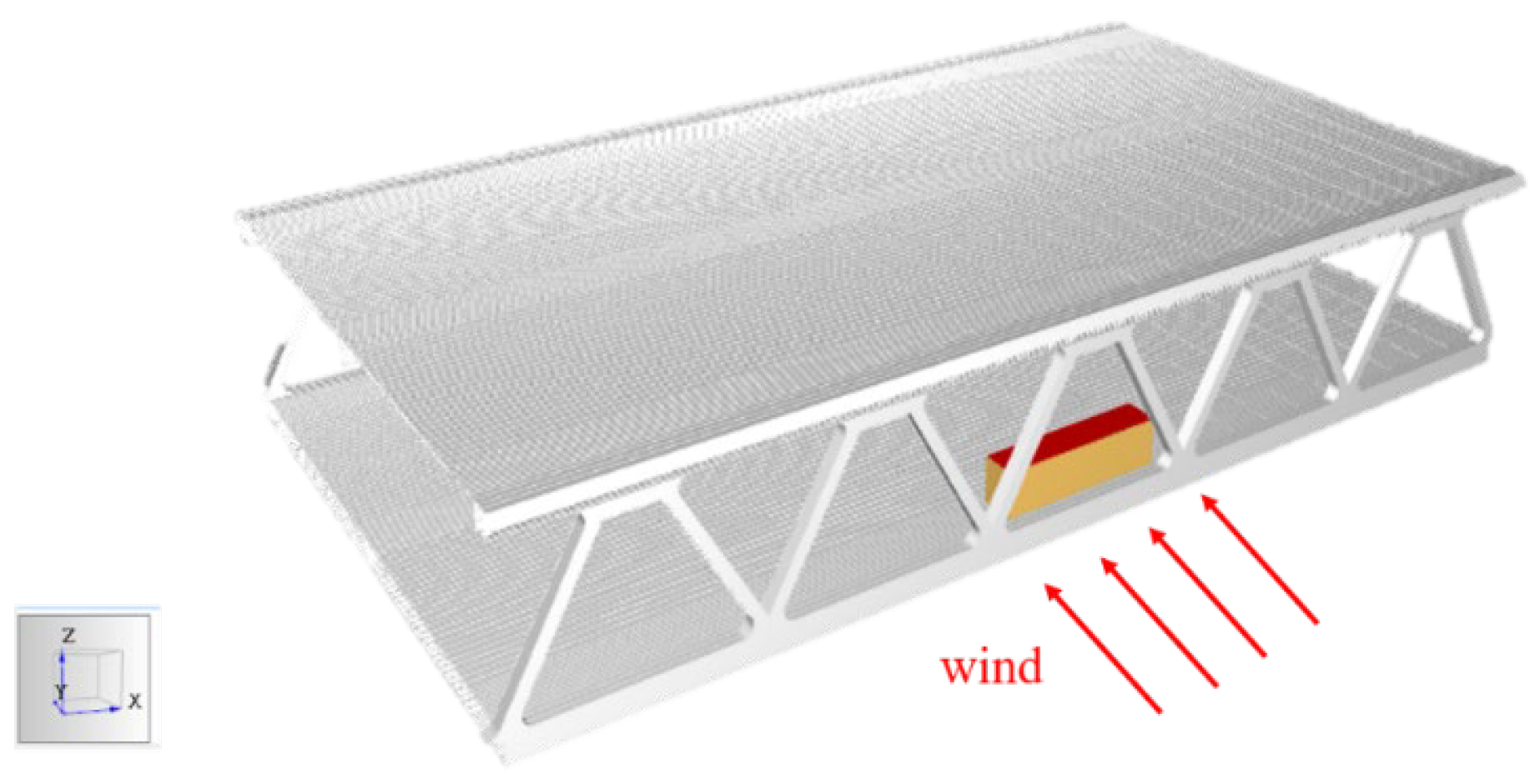

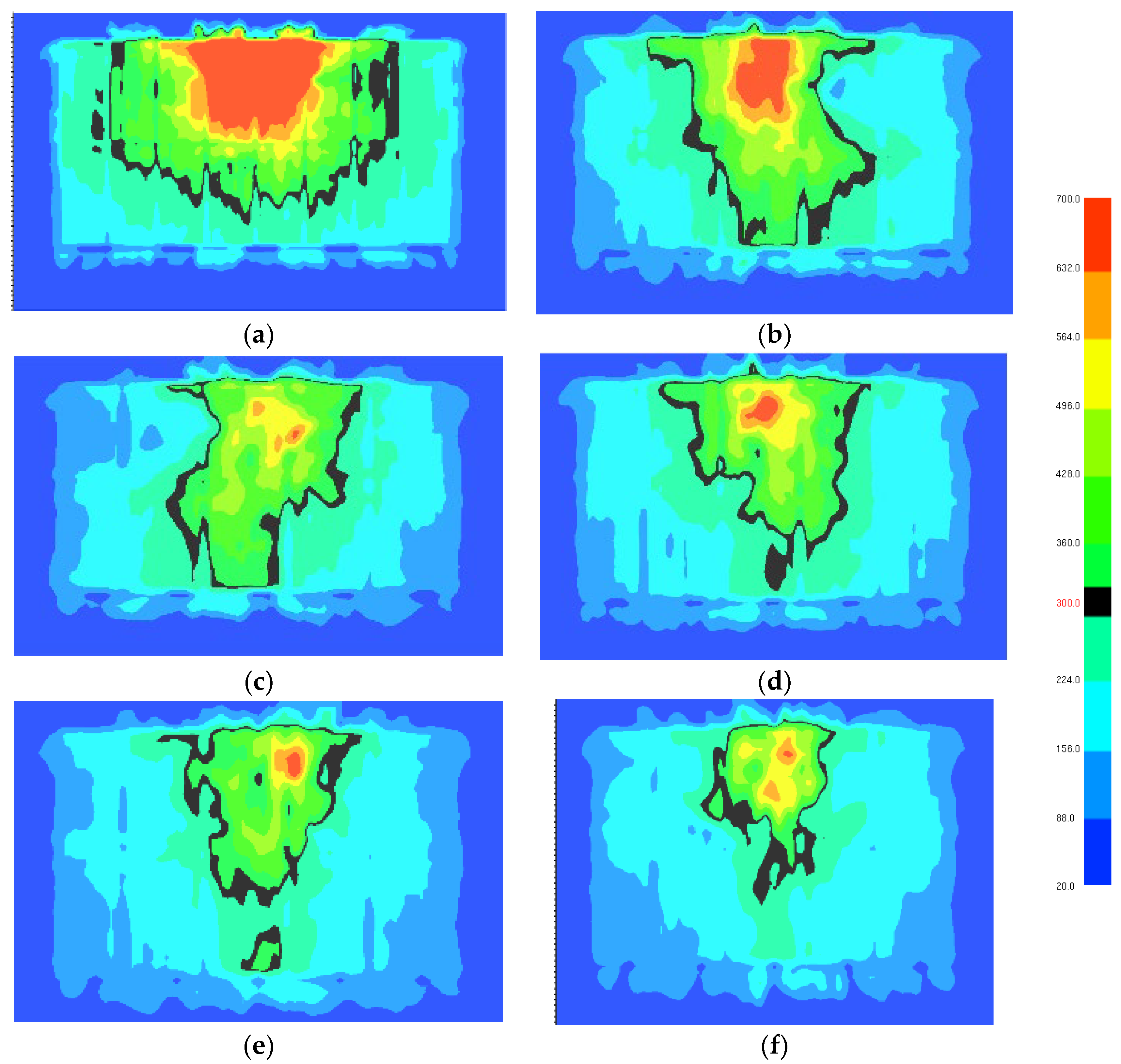
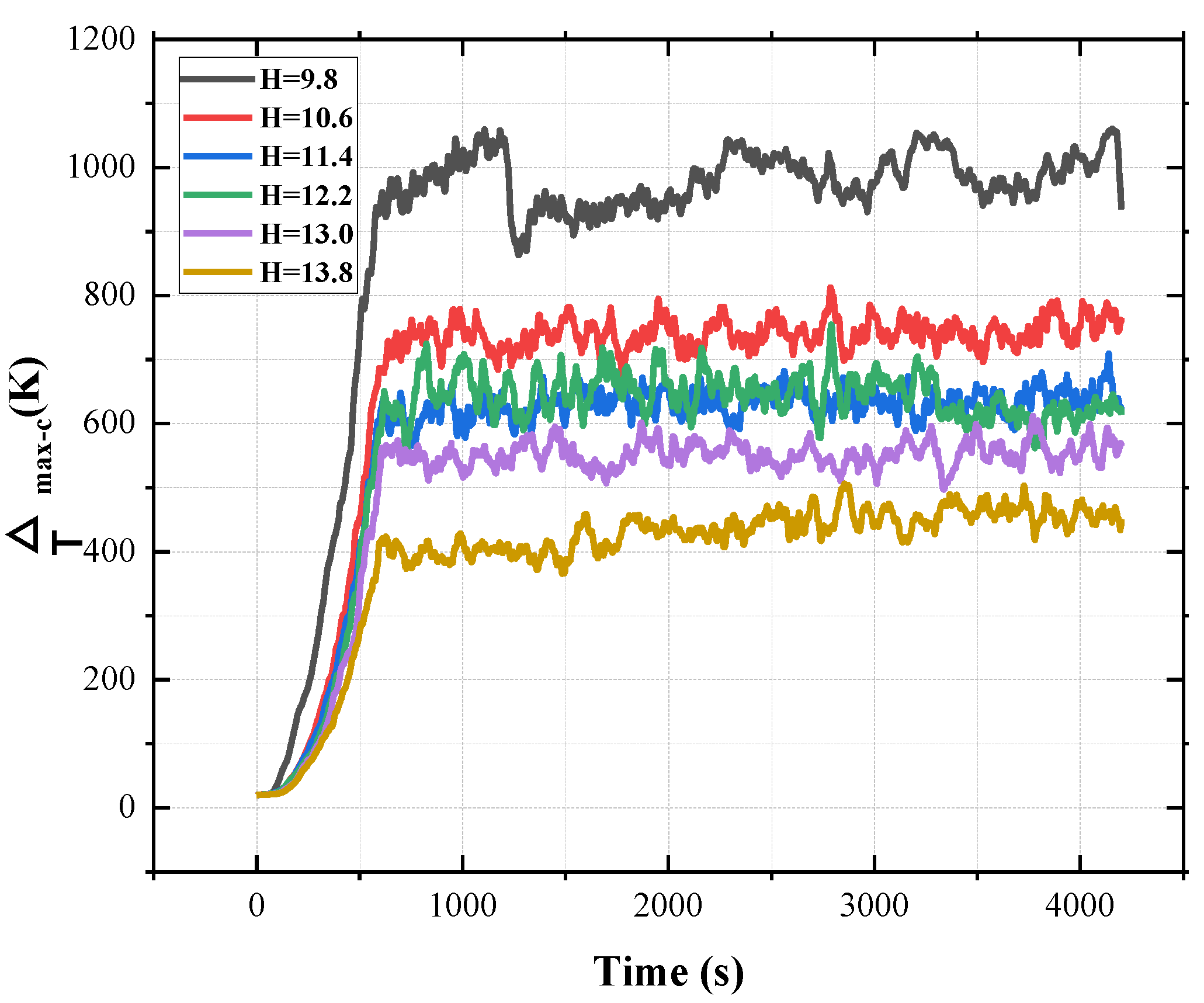
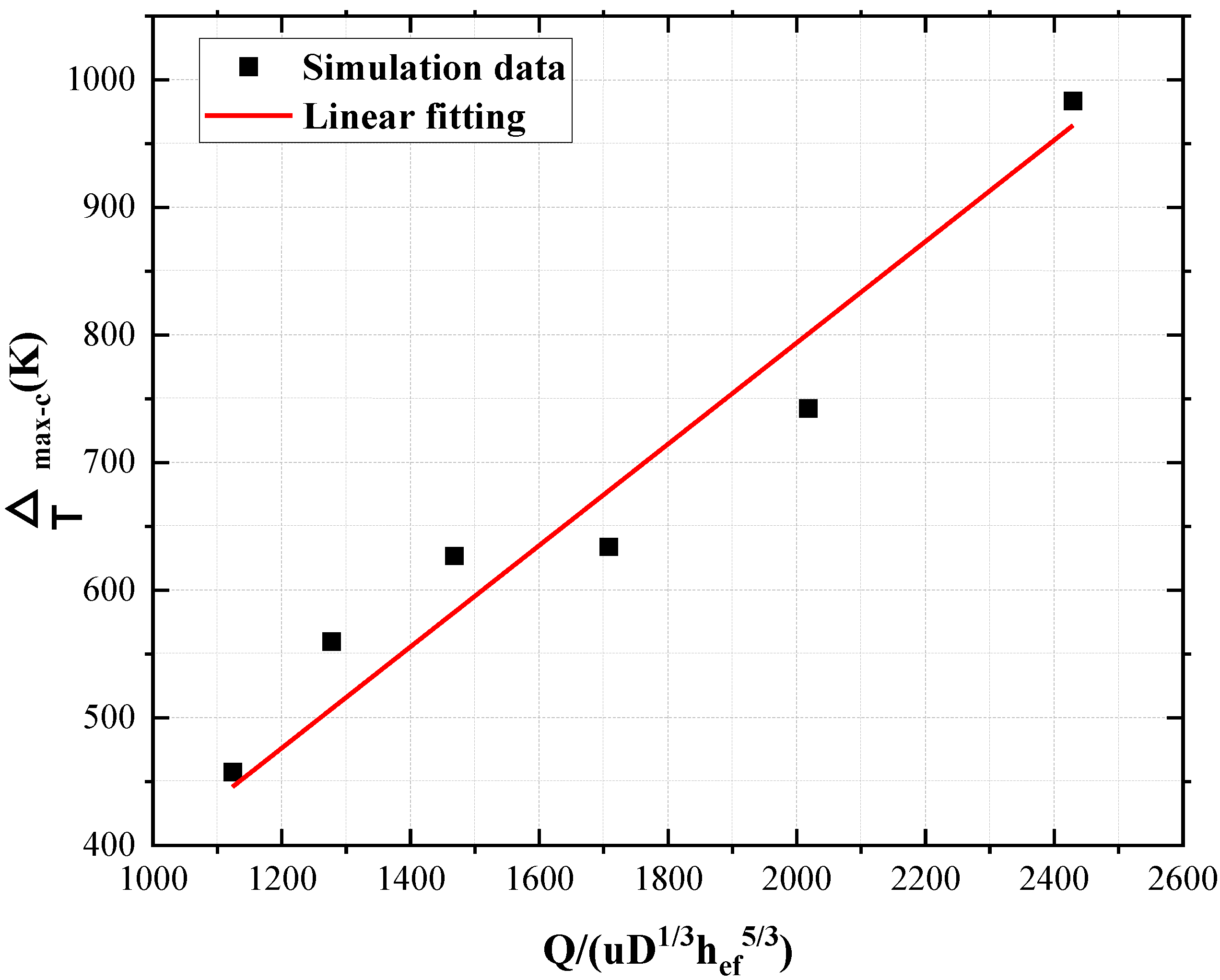


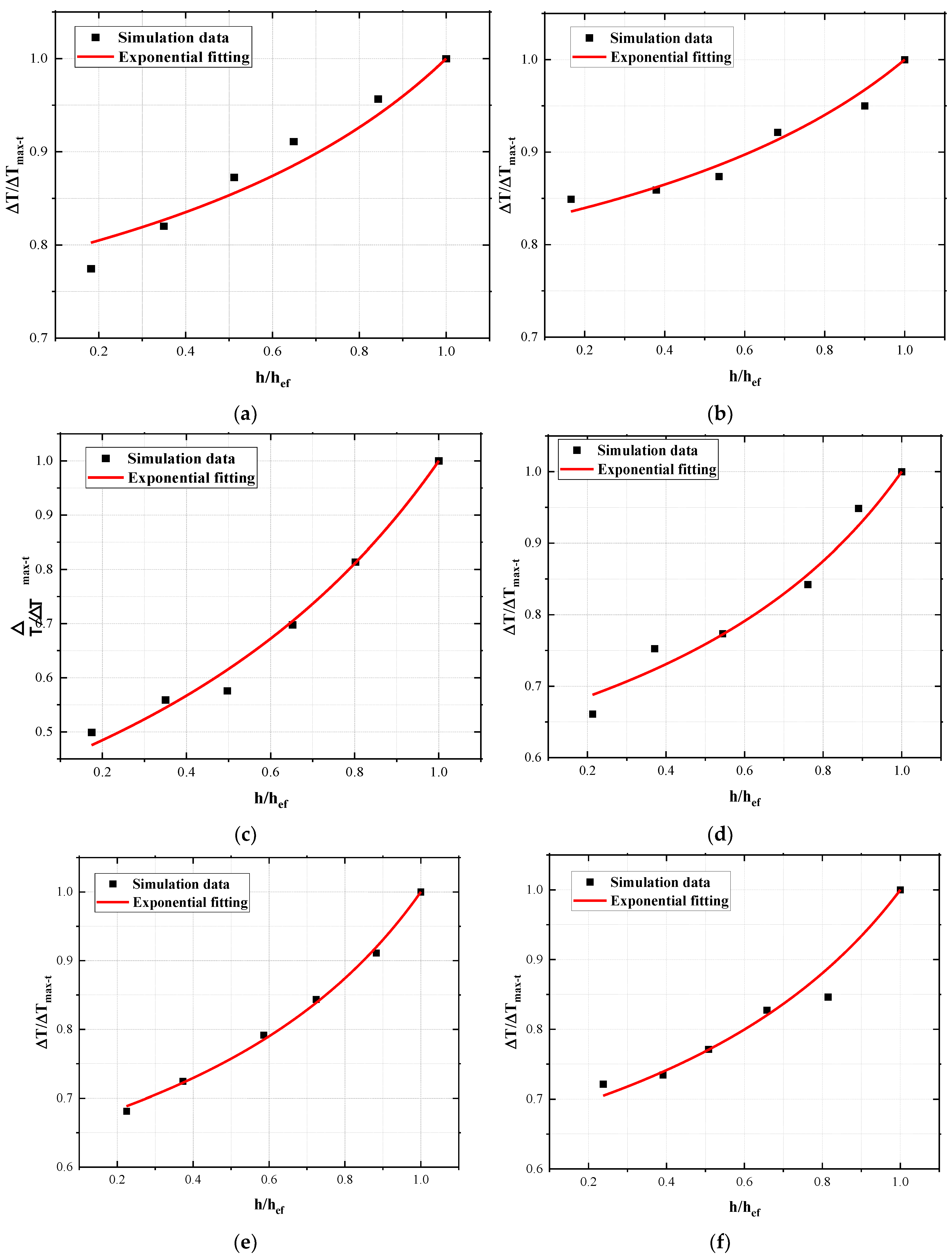
| Property | Material | Thermal Conductivity (W/m2 K) | Density (kg/m3) | Specific Heat (kJ/kg K) |
|---|---|---|---|---|
| Bridge | Steel | 47.56 | 7850 | 0.48 |
| Settings | Parameters |
|---|---|
| Ambient temperature | 20 °C |
| Ambient pressure | 101,300 Pa |
| Humidity | 40% |
| Ventilation velocity | 2 m/s |
| Bridge material | steel |
| Simulation time | 4200 s |
| Fire type | t2 unsteady state |
| Mesh size | 1 m × 1 m × 1 m |
| H = 9.8 | H = 10.6 | H = 11.4 | H = 12.2 | H = 13.0 | H = 13.8 | |
|---|---|---|---|---|---|---|
| k′ | 1.06 | 0.84 | 4.65 | 4.43 | 1.872 | 1.77 |
Publisher’s Note: MDPI stays neutral with regard to jurisdictional claims in published maps and institutional affiliations. |
© 2022 by the authors. Licensee MDPI, Basel, Switzerland. This article is an open access article distributed under the terms and conditions of the Creative Commons Attribution (CC BY) license (https://creativecommons.org/licenses/by/4.0/).
Share and Cite
An, W.; Shi, L.; Wang, H.; Zhang, T. Study on the Effect of Bridge Deck Spacing on Characteristics of Smoke Temperature Field in a Bridge Fire. Fire 2022, 5, 114. https://doi.org/10.3390/fire5040114
An W, Shi L, Wang H, Zhang T. Study on the Effect of Bridge Deck Spacing on Characteristics of Smoke Temperature Field in a Bridge Fire. Fire. 2022; 5(4):114. https://doi.org/10.3390/fire5040114
Chicago/Turabian StyleAn, Weiguang, Lei Shi, Hailei Wang, and Taike Zhang. 2022. "Study on the Effect of Bridge Deck Spacing on Characteristics of Smoke Temperature Field in a Bridge Fire" Fire 5, no. 4: 114. https://doi.org/10.3390/fire5040114





